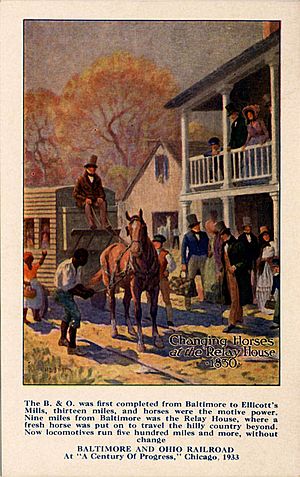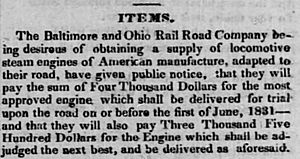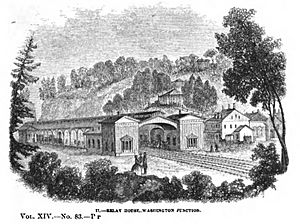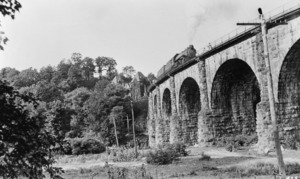Relay, Maryland facts for kids
Relay, Maryland was once a very important train stop. It was located about 9 miles west of Baltimore, Maryland. This spot was a busy junction for the Baltimore and Ohio Railroad. In fact, it was the second busiest station on the entire line, right after Baltimore itself!
A small town grew up around this train stop. It had a general store, a school, and even a volunteer fire company. Today, people still live in the area. But the old town of Relay has mostly disappeared. There is no longer a town government or a post office. There are also no stores left. However, the old fire house building still stands. It's at 1710 Arlington Avenue and can be rented for events. In 2021, Relay became a historic district within Halethorpe, Maryland. You can find it near where Viaduct and Railroad Avenues meet today. There is still a Relay Elementary School in the area.
Train Stations at Relay
Over the years, a few different buildings served as train stations at Relay. They were all built close to the same spot. Sometimes, people get them confused.
Here are the main buildings:
- The original Relay House: This was a wooden building. It still exists today, but it looks different after being rebuilt.
- The Relay House Station: This building was at the point where two train lines met. It was torn down a long time ago.
- The Viaduct Hotel: This was a stone building. It was also called the Relay Hotel. It was demolished in 1950.
The First Relay House
The first Relay House was a large building. It had three stories and 32 rooms. It worked as a restaurant, an inn, and stables for horses. This was for horse-drawn train cars. These cars traveled between Baltimore and Ellicott's Mills, which was about 13 miles away. This was the very first part of what would become the main Baltimore and Ohio Railroad line. This line eventually went all the way to Wheeling, which is now in West Virginia.
Back then, the main cargo was barrels of flour. These came from the mills and were taken to Baltimore. People could also ride these horse-drawn trains. The "relays" were the horses themselves. They would be swapped out for fresh horses at the Relay House.
A famous story, which might be a legend, happened here in 1830. It was a race between a horse and a new steam engine. The engine was called the Tom Thumb. It was the first train engine built in America. The race started in Baltimore and finished at the Relay House. The engine had a problem, and the horse won. But the race still showed that steam engines could work!
This original Relay House building is still standing today. It is now a private home. Because of a fire and later repairs, it looks different. It sits a little bit behind where the train tracks are now. When the Thomas Viaduct opened, the tracks were moved slightly. So, the train line no longer passed right in front of the Relay House. You can still see some parts of the old 1830 tracks that are no longer used. Link to a picture of this building.
The Relay Station
In 1835, the Thomas Viaduct opened. This bridge allowed trains to travel to Washington, D.C., for the first time. After this, horses were no longer used to pull the train cars. The train tracks were moved a little bit. This meant the original Relay House was no longer right next to the tracks.
New platforms were built along the tracks. These had benches and roofs for passengers. But the Relay House was still close enough. Trains could stop there so passengers could have a meal break. On train maps and schedules, this stop was simply called "Relay." The Thomas Viaduct is still used by trains today! 1878 B&O Railroad Map
Before the American Civil War, Relay was a very important train station. It was a major meeting point for trains. The track from Washington, D.C., joined the main Baltimore-Wheeling line here. It was a complicated station with a special "wye junction" track layout. Relay was the second busiest station on the line. Only Baltimore was busier. The names "Relay" and "Relay House" often appeared in reports. These reports were about John Brown's raid on Harpers Ferry. This was a big event just before the Civil War started. The war caused train operations to stop for a while.
The Viaduct Hotel
After the Civil War, many repairs were needed. For example, the B & O Railroad Potomac River Crossing at Harpers Ferry, West Virginia had been blown up. Once repairs were done, trains could run normally again. In 1872, the Railroad built a new building. It was a four-story hotel and station made of granite. This was called the Viaduct Hotel. People also called it the Relay Hotel.
This was not a normal hotel for tourists. It was mainly for train workers and passengers. Trains would stop here for scheduled meal times. Passengers who were changing trains might have to wait for hours at Relay. The hotel had a barber shop and a post office. It was also used for railroad meetings and dinners. Sometimes, railroad workers lived there too.
Around 1900, trains became much faster. Also, new features like dining cars and sleeping cars were added to trains. This made the Viaduct Hotel less useful. It slowly lost customers and finally closed in 1938. The building was torn down in 1950. A marker that used to be at the hotel's site is now in the Baltimore and Ohio Railroad Museum in Baltimore. A small model of the hotel has also been built.






